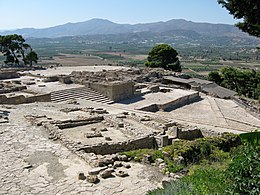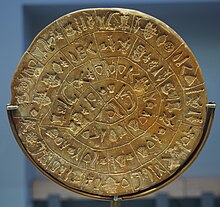| Phaistos Disc | |
|---|---|
Phaistos Disc, side A (top) and side B (bottom) | |
| Material | Clay |
| Created | 2nd millennium BC |
| Discovered | July 3, 1908 Phaistos, Crete, Greece |
| Discovered by | Luigi Pernier |
| Present location | Heraklion Archaeological Museum, Crete, Greece |

The Phaistos Disc or Phaistos Disk is a disk of fired clay from the island of Crete, Greece, possibly from the middle or late Minoan Bronze Age (second millennium BC), bearing a text in an unknown script and language. Its purpose and its original place of manufacture remain disputed. It is now on display at the archaeological museum of Heraklion. The name is sometimes spelled Phaestos or Festos.
The disk was discovered in 1908 by the Italian archaeologist Luigi Pernier during the excavation of the Minoan palace of Phaistos.[1] The disk is about 15 cm (5.9 in) in diameter and is covered on each side with a spiral text, consisting of a total of 241 occurrences of 45 distinct signs, which were created by pressing individual sign stamps onto the soft clay before firing. While its unique features initially led some scholars to suspect a forgery or hoax, the disk is now generally accepted as authentic by archaeologists.
This mysterious object captured the imagination of amateur and professional palaeographers, and many attempts have been made to decipher the code behind the disc's signs.[2] While it is not clear that it is a script, most attempted decipherments assume that it is; most additionally assume a syllabary, others an alphabet or logography.

